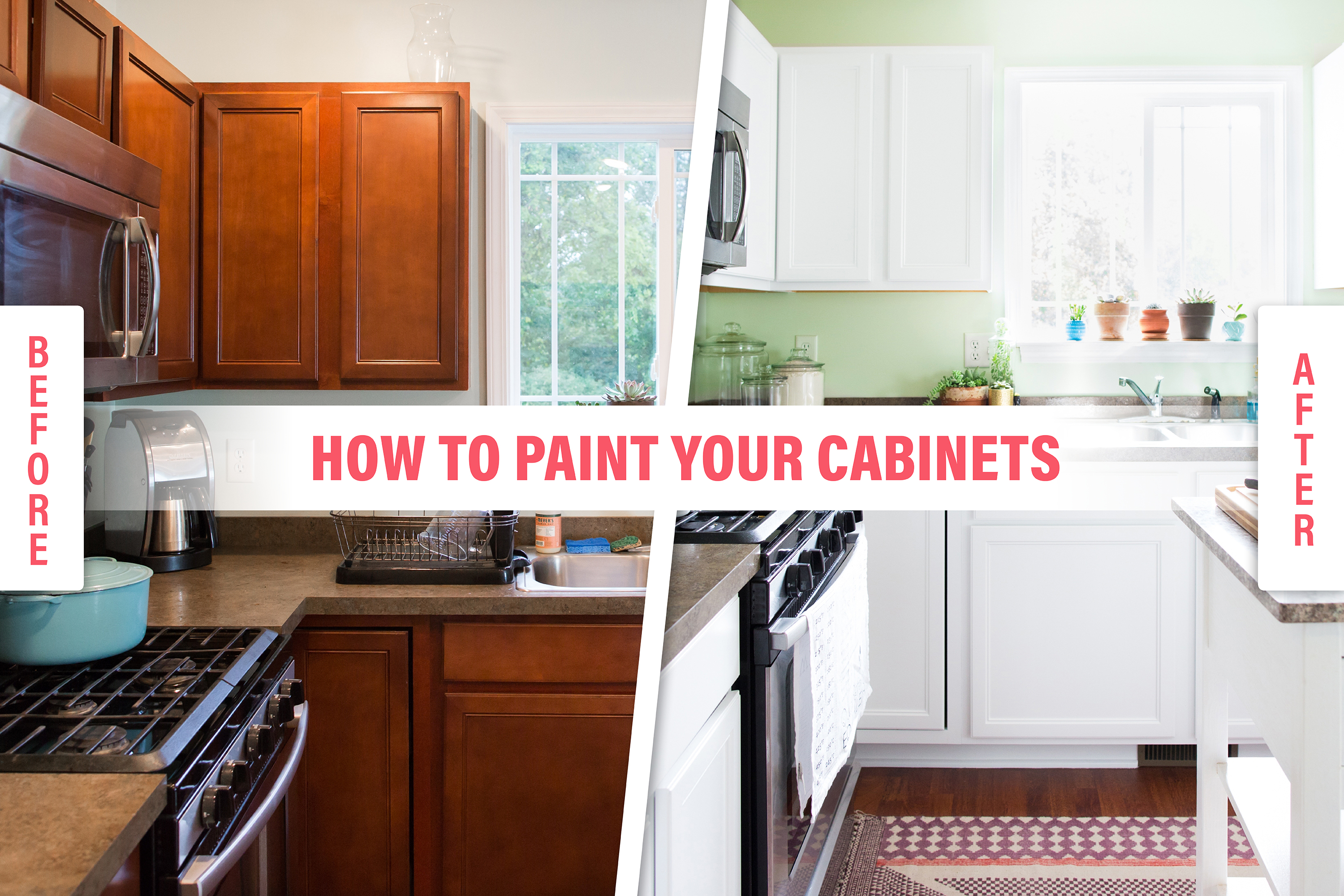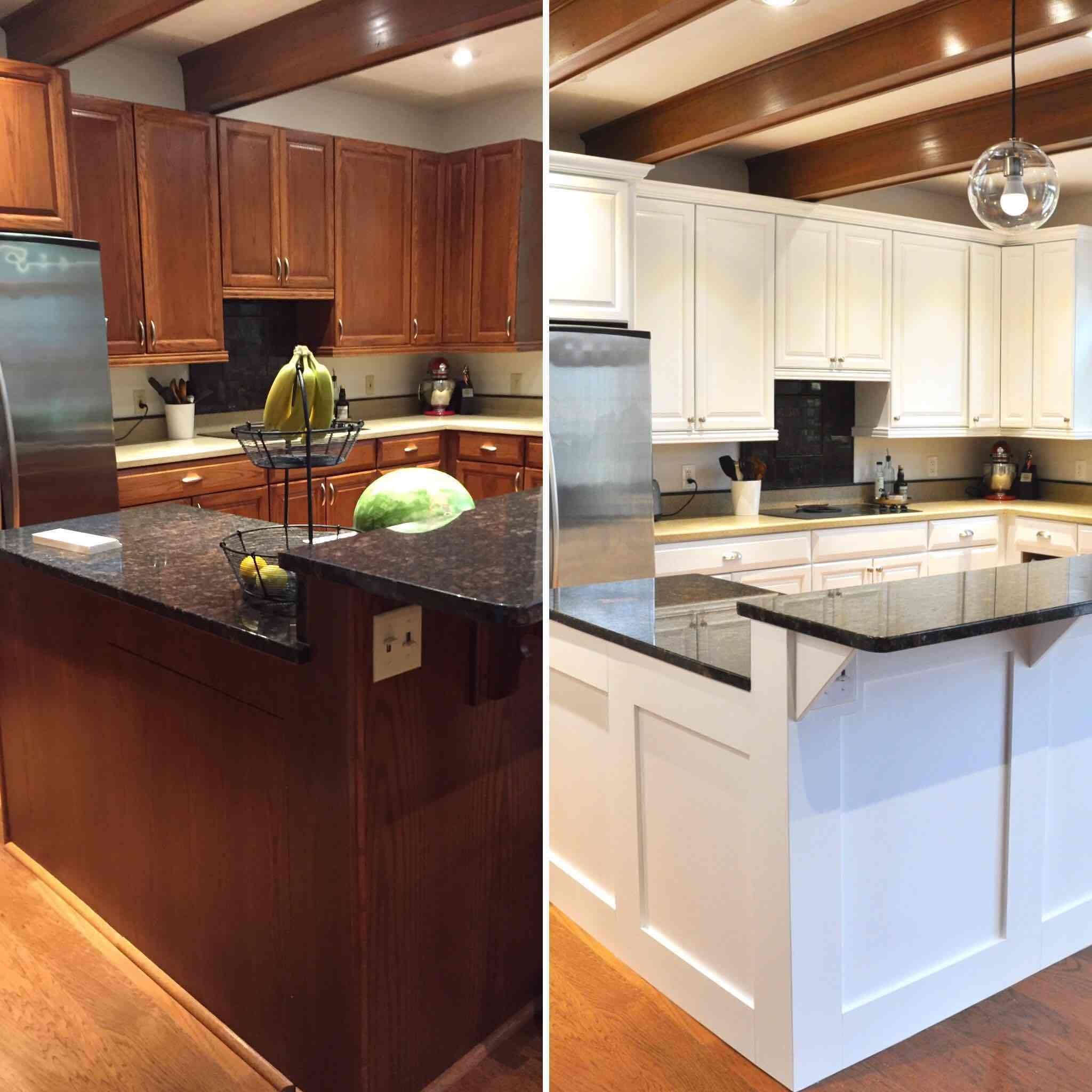Preparation and Surface Preparation for Spray Painting Oak Cabinets White

Transforming oak cabinets from their natural hue to a crisp white requires meticulous preparation. Failure to adequately prepare the surface will result in a subpar finish, characterized by peeling paint, uneven color, and a generally unprofessional appearance. This process, while demanding, is crucial for achieving a durable and aesthetically pleasing result. The following steps Artikel the necessary procedures to ensure a successful paint job.
Cleaning Oak Cabinets
Thorough cleaning is paramount before any sanding or filling. Oak, being a porous wood, readily absorbs dirt and grime, which can interfere with paint adhesion. Use a degreasing cleaner, such as TSP (trisodium phosphate), diluted according to the manufacturer’s instructions. Apply the solution with a soft cloth or sponge, paying close attention to areas prone to grease buildup, such as handles and cabinet doors. Rinse thoroughly with clean water and allow the cabinets to dry completely before proceeding to the next step. Failure to completely remove grease will compromise the bond between the primer and the wood. This negligence can lead to premature paint failure and necessitate costly rework.
Sanding Oak Cabinets, Spray painting oak cabinets white
Sanding smooths the surface, removes imperfections, and creates better paint adhesion. Begin with a coarser grit sandpaper (120-grit) to remove any significant imperfections or old finish. Gradually progress to finer grits (180-grit, then 220-grit) for a progressively smoother surface. Always sand in the direction of the wood grain to avoid scratching. Excessive sanding can remove too much material and compromise the structural integrity of the cabinets. This is particularly critical with older cabinets which might be more susceptible to damage.
| Sanding Technique | Grit | Effectiveness | Suitability |
|---|---|---|---|
| Hand Sanding | 120-220 grit | Good for detail work and smaller areas; less efficient for large surfaces. | Best for intricate details and smaller projects. |
| Orbital Sander | 120-220 grit | Highly efficient for large, flat surfaces; can leave swirl marks if not used carefully. | Ideal for large cabinet surfaces but requires skill to avoid imperfections. |
| Palm Sander | 120-220 grit | Offers a balance between control and efficiency; less aggressive than orbital sanders. | A good compromise between hand sanding and orbital sanding. |
| Random Orbital Sander | 120-220 grit | Provides a very smooth finish with minimal swirl marks; requires careful control. | Best for achieving a professional-level finish, but requires practice. |
Filling Imperfections in Oak Cabinets
Wood filler is used to repair cracks, gouges, and other imperfections. Choose a high-quality wood filler that matches the color of the oak as closely as possible. Apply the filler according to the manufacturer’s instructions, using a putty knife to smooth it into the imperfections. Allow the filler to dry completely before sanding it flush with the surrounding surface using fine-grit sandpaper (220-grit or higher). Improperly filled imperfections will become noticeable under the paint, compromising the overall aesthetic appeal. This is especially true with lighter-colored paints like white.
Priming Oak Cabinets
Priming is crucial for achieving a smooth, even finish and ensuring good paint adhesion. Oak, with its inherent porosity, requires a primer to seal the wood and prevent the paint from being absorbed unevenly. A high-quality bonding primer is recommended, especially for surfaces that have been heavily sanded or repaired.
- Oil-based primer: Offers excellent adhesion and durability, but requires more drying time and can have a strong odor.
- Water-based primer: Dries quickly, has less odor, and is easier to clean up, but may require multiple coats for optimal coverage.
- Sheen primer: Provides a smoother surface for a more even topcoat application.
- Stain-blocking primer: Essential if the oak cabinets have any existing stains or discoloration that you want to cover.
Apply the primer using a high-quality brush, roller, or spray gun, ensuring even coverage. Allow the primer to dry completely before applying the white paint. Skipping this crucial step will almost certainly lead to an uneven and unsatisfactory paint job, highlighting imperfections and requiring extensive remedial work.
Spray Painting Techniques and Considerations for Oak Cabinets: Spray Painting Oak Cabinets White

Spray painting oak cabinets white presents a unique set of challenges, demanding precision, patience, and a firm grasp of proper techniques. Failure to adhere to best practices can result in an amateurish finish, wasted materials, and a costly redo. This section will detail the crucial steps involved in achieving a professional-looking result. Ignoring these steps is a recipe for disaster.
Spray Gun Setup and Paint Selection
Proper spray gun setup is paramount. The air pressure must be carefully calibrated to the viscosity of the paint and the nozzle size. Too much pressure leads to overspray and runs, while too little results in a dry, uneven finish. The paint viscosity should be adjusted to ensure a smooth, even flow from the gun. This requires careful attention to the manufacturer’s instructions and potentially some experimentation. Choosing the right paint is equally crucial. The following table compares different spray paint types:
| Spray Paint Type | Drying Time | Durability | Cost |
|---|---|---|---|
| Lacquer | Fast | High | High |
| Enamel | Moderate | High | Moderate |
| Acrylic | Moderate | Moderate | Low |
The choice depends on factors such as budget, desired durability, and drying time constraints. Lacquer offers superior durability and a fast drying time but comes at a higher cost. Enamel provides a good balance of durability and cost-effectiveness, while acrylic is the most affordable option, though it might not offer the same level of durability. Selecting a sheen level is also crucial; satin or eggshell finishes tend to mask imperfections better than high-gloss.
Application Techniques
The application process itself requires meticulous attention. Multiple thin coats are far superior to one thick coat. Each coat should be allowed to dry completely before applying the next. Overlapping each pass by approximately 50% ensures even coverage. Maintain a consistent distance between the spray gun and the cabinet surface to avoid variations in paint thickness. A steady, even motion is key; jerky movements lead to uneven coverage and an unprofessional finish. The “wet-on-wet” technique, where slightly overlapping coats are applied before the previous coat fully dries, can help achieve a smoother finish. However, this requires experience and careful monitoring of drying times to prevent runs.
Ventilation and Safety Precautions
Spray painting indoors without proper ventilation is akin to political suicide; the fumes are toxic and can cause serious health problems. Adequate ventilation is non-negotiable. This includes using respirators, ensuring sufficient airflow, and potentially working outdoors. Protective gear is also essential; neglecting this aspect is irresponsible and reckless.
- Wear a respirator designed for spray paint fumes.
- Use safety glasses or a face shield to protect your eyes.
- Wear disposable gloves to protect your hands.
- Work in a well-ventilated area, preferably outdoors.
- Dispose of spray cans and other materials responsibly.
Troubleshooting Common Problems
Even with careful preparation and technique, problems can arise. Drips and runs are often caused by excessive paint application or too high air pressure. Uneven coverage results from inconsistent spray distance, inadequate overlapping, or insufficient coats. Orange peel is a common texture issue caused by improper spray gun settings or too much air pressure.
Addressing these issues requires a methodical approach. Drips and runs can be sanded smooth after drying, while uneven coverage requires additional coats. Orange peel can sometimes be mitigated by applying a very fine wet sanding between coats, followed by a final topcoat. But preventing these issues in the first place is far more efficient. Failure to address these problems will result in a subpar finish, requiring costly and time-consuming remediation.
Post-Painting Procedures and Finishing Touches for White Oak Cabinets

The final stages of painting oak cabinets white are crucial for achieving a professional, durable finish. Neglecting proper post-painting procedures can compromise the entire project, leading to an uneven surface, premature wear, and ultimately, wasted time and resources. This section details the essential steps to ensure a flawless result.
Cleaning Spray Equipment
Thorough cleaning of spray equipment immediately after use is paramount to prevent paint from hardening and rendering the equipment unusable. Failure to do so results in costly replacements and contributes to environmental waste. The specific cleaning process varies depending on the type of spray gun. For airless sprayers, immediately flush the system with the appropriate solvent recommended by the paint manufacturer, typically a thinner compatible with the paint used. This involves running the solvent through the entire system, including the hose and gun, until the solvent runs clear. For HVLP (High Volume Low Pressure) spray guns, disassemble the gun according to the manufacturer’s instructions and soak the components in the recommended solvent. Use a brush to clean any stubborn paint residue. Thoroughly rinse all parts with clean solvent and allow them to dry completely before storage. For conventional spray guns, a similar process of flushing and disassembling is required, paying close attention to the nozzle and air cap, which are particularly prone to clogging. Remember, always consult the manufacturer’s instructions for your specific equipment.
Achieving a Smooth, Even Finish
Even with meticulous application, minor imperfections may occur. Light sanding between coats can help create a smoother, more even surface. Use fine-grit sandpaper (320-400 grit) to gently sand the dried paint, paying attention to any runs, drips, or uneven areas. Always sand in the direction of the grain to avoid creating scratches. Remove sanding dust with a tack cloth before applying the next coat. This process may be repeated for multiple coats, depending on the desired finish. Applying a clear coat, once the paint is completely dry and sanded smooth, adds a protective layer and enhances the durability and shine of the finish.
Clear Coat Options
The choice of clear coat significantly impacts the final look and durability of the cabinets. Several options exist, each with its own advantages:
- Water-based polyurethane: Easy to clean up, low odor, and relatively fast drying time. However, it may not be as durable as oil-based options.
- Oil-based polyurethane: Offers superior durability and scratch resistance, but has a strong odor and requires mineral spirits for cleanup. Drying time is also longer.
- Acrylic lacquer: Dries quickly, offering a hard, durable finish with excellent clarity. It’s more expensive than polyurethane, however.
- Shellac: A natural resin-based finish, offering a warm, amber tone. It’s less durable than polyurethane or lacquer and requires more coats for adequate protection.
The best choice depends on the desired level of durability, budget, and personal preference.
Handling Imperfections
After the paint has dried and the clear coat (if applied) has cured, inspect the cabinets carefully for any imperfections. Minor imperfections, such as small scratches or blemishes, can often be addressed with touch-ups. Use a small brush or toothpick to carefully apply a small amount of paint to the affected area, blending it seamlessly with the surrounding paint. For more significant imperfections, such as runs or drips, light sanding followed by touch-up paint and another clear coat may be necessary. In cases of more severe damage, it might be necessary to repaint the entire cabinet door or drawer. Remember, patience and precision are key to successful touch-ups. Rushing the process will likely result in noticeable imperfections.
